
| The All-Vacuum-Tube Nixie Clock! | Heisterkamp
- Jan 2005 |
 |
Finally....it's finished! A completely digital clock without any semiconductors. No ICs, no micros, no transistors, not even a diode! The only silicon is in the glass of the 40 glorious electron and Nixie display tubes!
So what prompts a person to build such a thing? It's certainly not efficient, nor space-saving. It's not practical to run it continuously and due to its nature, it's a bit cantankerous when you load the mains with RF hash. But you know what? It's just plain cool! It's glass, steel, neon and electrons, all wrapped up in a crinkle finish.
Size...believe it or not, this is about as compact as I could envision the unit: 6" x 10" x 18" The counting modules alone make up the unit's height. Two power transformers on the rear supply the requisite B+ and B- voltages. The knurled thumbscrews are functional and fasten the modular panels together. The rear panel being four 6AX4s and two 6X4s as the rectifiers for the counting modules, plus the pulse generator circuit comprised of an 0A3 and 6AX5, and a neat little divide-by-6 circuit designed by Morris Odell utilizing a 6J6, 6AS6, 6AL5, 6802 dekatron and an additional 6J6 to interface with the counters. Counter module B supply regulators are on the rear valence with the power transformers.
Forward of the rear panel are 5 rows of industrial 5963s that make up the flip-flops of the counter modules, which are modified units from a Beckman Frequency Counter circa 1958. The 5092 Nixies are coupled to the NE-2ish indicators of the modules via photocells, in the spirit of HPs counting modules. Paralleling cells made simple work of indicating the leading 1 in 10,11 & 12. And because of their reaction time, digit changes are smooth. In the interest of keeping the footprint small, and supporting the nixies and the weight of the top panels, there is special bracing with countersunk screws that are hidden. In fact, space is tight enough that each panel is dependent upon the prior for removal, with the first being the front.
The switches come from vintage IBM mainframe equipment
and really fit the look of the machine.
From left to right, the switches are: A) Power on/off. B) Display on/off/dim.
C) Hours Set. D) 10Minute Set. E) 1Minute Set.
The colons go off when in dim mode, or anytime the time is being set.
Along the back is a v.regulator adjustment for the module supplies, a courtesy 120v outlet, fuse holder and an octal socket in case I want to provide input/output one day with another device. There's a knob and banana jack on the upper rear portion of the unit that adjusts the clock speed.
You can take a look at Jim Forbes's (modern english) modified Beckman clock here to get an idea of how the modules are connected and what they actually look like. In order to keep the "plug end" of the module from interfereing with the Nixies, the modules were spun 180°. But this presented a problem. I wanted the 6-count modules (that only have 3 tubes) to have their tubes lined up at the front with the 4 tube units. So this involved drilling out the socket closest to the plug end, and rewiring the unused socket at the other end. Then all the modules were modified to mount with a beveled screw between sockets 2 and 3 to fasten them to the top panel. But it was worth it~
The sheetmetal was reused from a previous project and was flat in form; all the cutting and bending was done with a 6" vise and hand tools!
The only problem the clock has at this moment is a tendency to start jumping ahead by seconds at a time whenever a cheap powersupply or dimmed light is kicked on. Obviously such things weren't a problem in 1958. I'll fit a modern day filter on the input and see if I can clear that up.
-Update: Skipping has been largely supressed on noisy sources with a cap value tweak on the output of the pulse circuit. Additional mods were made to the connection of the time-set toggles to stablize time setting. This clock now runs at my desk at work, 8 hours at a time, without skipping a beat!
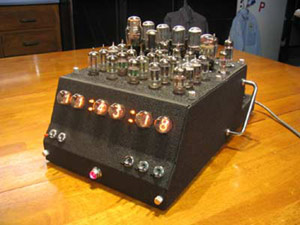 The finished Clock |
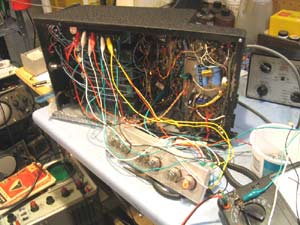 Testing the CdS arrays |
 Rear features |
||
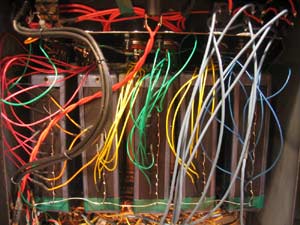 Modules & Nixies |
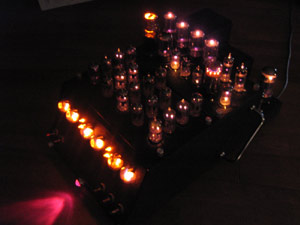 1/2S exposure - Note the dekatron |
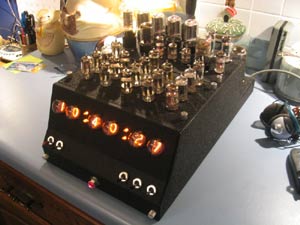 |